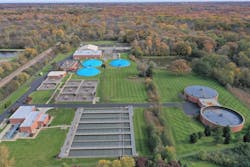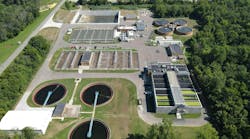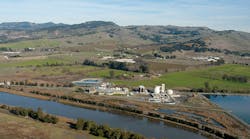Mundelein Wastewater Treatment Plant is located in the village of Mundelein, Lake County, Illinois, which is situated in the northern suburbs of Chicago.
Paul Cacioppo is Utilities Superintendent of Mundelein Wastewater Treatment Plant. Cacioppo’s goals are to exceed U.S. EPA regulations on a daily basis and to be a good steward of the environment. The plant’s team consists of a lab tech, two maintenance workers, a foreman, and clerk, alongside Cacioppo.
The facility treats about 3.5 million gallons a day (mgd) and the design flow is 4.95 mgd. The village of Mundelein’s sole wastewater plant collects and treats wastewater for approximately 31,000 residents, and according to Cacioppo, the community is still growing. Mundelein maintains 95 miles of gravity sanitary sewer lines, 1.05 miles of force main sanitary sewer lines, and 57 miles of storm sewer lines.
“My biggest accomplishment is continuously exceeding our limits set by the EPA,” said Cacioppo about his time at the facility. “I love that we’re doing something for the environment, we’re making a difference.” Beyond working to exceed limits set by the U.S. EPA, the village of Mundelein also complies with OSHA's Process Safety Management Program.
Several practices are implemented at the WWTP to comply with the needs of the prevention program. These practices include: thorough training of employees; inspection of chlorine containers prior to accepting delivery; rigorous inspections twice a day of the chlorine container rooms; and daily tests of the chlorine gas detector alarms.
The facility conducts phosphorus removal and uses activated sludge with anaerobic digestion as treatment methods.
The wastewater treatment process begins with fine-screening (3/8th of an inch), then the water goes to grit removal, primary tanks, and then the solids go to anaerobic digestion and the water goes to activated sludge tanks. The facility has six activated sludge tanks. After going through secondary clarifiers, the water goes through sand filtration and tertiary treatment, which uses sodium hypochlorite for disinfection and sodium thiosulfate for chlorine removal.
The last big project for the WWTP was four years ago, targeting phosphorus removal. The facility installed an addition to one of the buildings, where two 5,000 gallon tanks were installed for chemical removal of phosphorus.
“For the most part, it’s smooth sailing,” said Cacioppo. “We are also in the process of investigating biological phosphorus removal, and we’re using a sidestream process which we’ve been trying for the last year. We feel like we’re getting close.”
According to Cacioppo, his team went from six sanitary backups to zero sanitary backups. The facility has also overcome the challenge of mitigating impacts to the floodplain and surrounding area, since it is located adjacent to the Des Plaines River in Lake County, Illinois. Due to its proximity, the WWTP property includes areas of wetland and 100-year floodplain. The village wanted to co-locate a new 1.5-acre wetland/prairie restoration area within the required compensatory storm water storage area, creating a wetland that tackles storm water runoff before it enters the Des Plaines River, as well as a habitat for wildlife.
The result is a new wetland area that naturally cleans diverted storm water runoff of sediment and chemicals by allowing it to leach into the ground, evaporate into the air or be absorbed by the wetland plants.
“What distinguishes us from other treatment plants is we’ve got an extremely well-kept facility. As far as future projects we have, our next big project which we’re in the midst of doing, we’re doing a major rehab project to our digesters.”
The team hopes this $2 million dollar project will be done by next year.


